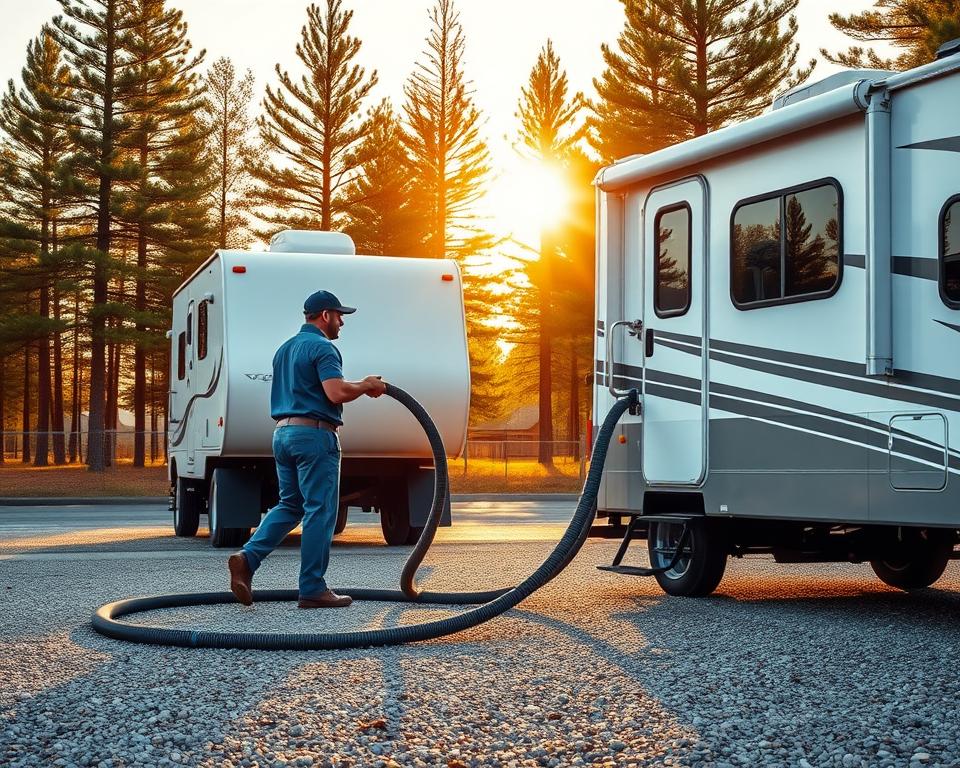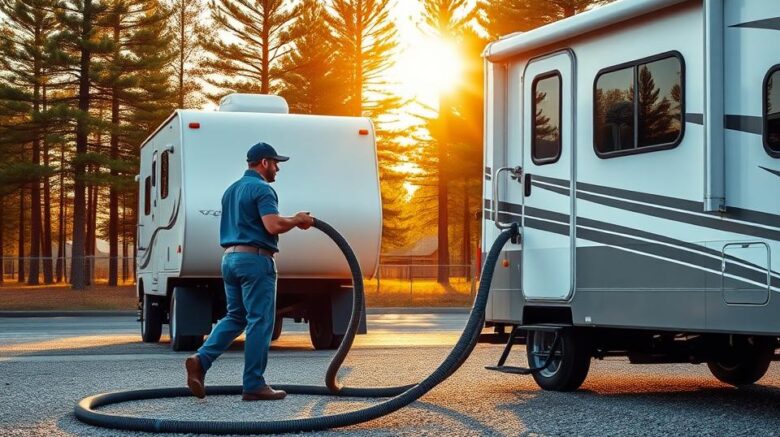Optimize Your RV Water System with a Pressure Tank
Have you considered the impact of an RV pressure tank on your camping trips? While journeying, your RV’s plumbing system becomes critical for everyday tasks such as bathing and dishwashing. Optimizing this system ensures a smooth and continuous water flow, vital on the road. Let’s explore how an RV pressure tank can improve your onboard water system – RV water tank and pump, heightening comfort during your adventures.
Main Points
- A camper pressure tank boosts flow on the move.
- Dependable pressure matters for routine use.
- Refining your water setup ups campsite comfort.
- Pressure tanks help maintain consistent water pressure.
- Better flow aids all plumbing operations.
The Value of Consistent Water Pressure in Your RV
Consistent plumbing is key to enjoyable RV trips. It ensures daily tasks like showering, washing dishes, and using the toilet are hassle-free. Challenges such as low water pressure can disrupt these activities, highlighting the necessity of proper water flow in your RV.
Low water pressure can stem from multiple problems. Leaks, clogged filters, or insufficient water supply are common causes. Not only do these problems interfere with convenience, but they can also escalate into larger issues without timely intervention. Thus, consistent maintenance is crucial for a well-functioning RV plumbing system.
Important aspects of maintaining a robust RV water system include:
- Scanning joints and hoses for seepage
- Cleaning or replacing clogged filters when necessary
- Employing a water pressure regulator to safeguard against surges
Keeping these practices top of mind empowers RV owners to enhance their water flow. It makes the camping experience enjoyable.

Role of the Pressure Tank in Your RV’s Water System
A pressure tank is essential to your camper’s plumbing. It ensures water pressure remains even and dependable. This component stores and buffers water, making it available even when demand peaks. It prevents the inconvenience caused by pressure fluctuations.
The design of an RV water pressure tank often features a bladder or diaphragm. This mechanism separates water from air, allowing for rapid pressurization. Understanding how a camper pressure tank works empowers RV owners to manage their plumbing. A quality motorhome pressure tank enhances water delivery’s reliability and efficiency.
Benefits of Pressure Tanks for Flow
An RV pressure tank plays a crucial role by providing consistent water flow. It avoids flow drop-outs under simultaneous use. When faucets, showers, and toilets operate together, a pressure tank maintains uniform pressure.
This tank takes the load off the pump system, leading to better energy use. It stores pressurized air, pushing water through the system. This results in the water pump runs fewer cycles. The result? Saved energy and an extended water pump life.
Thanks to these tanks, RV owners enjoy dependable water flow, enhancing their experience. No more weak streams or pauses. Knowing how a pressure tank works empowers users to avoid the hassle of varying water pressure.
| Characteristic | Benefit |
|---|---|
| Consistent Pressure | Provides reliable delivery for daily tasks |
| Less Pump Cycling | Decreases wear on your pump |
| Quick Water Delivery | Speeds up usage at any tap |
| Simple Setup | Simplifies upgrades to the RV water system |
Advantages of a Camper Pressure Tank
Adding a pressure vessel delivers multiple benefits. It leads to consistent water pressure, enhancing showering, cooking, and cleaning experiences. The absence of sudden water flow drops allows for smoother daily activities.
Another key benefit is the relief it offers your water pump. By maintaining steady pressure, the tank extends the pump’s lifespan and reduces service calls. This results in significant maintenance cost savings and less inconvenience over time.
Efficient water use is also a major plus. It helps avoid common pressure-related problems like leaks. These tanks boost plumbing system reliability, ensuring hassle-free trips. With proper setup and maintenance, they bring assurance and comfort.
Picking the Perfect Camper Pressure Vessel
Selecting the right tank involves several considerations to match your RV water system’s needs. Start by evaluating tank capacity. RV pressure tanks vary in size; knowing how much water you use will help pick the right one.
Material choice affects lifespan. Tanks made of stainless steel or polyethylene last longer and resist corrosion. It’s crucial to select a tank that handles road vibrations and varying climates.
Diaphragm tanks stand out when considering options. They efficiently maintain pressure and reduce water hammer. Reviewing specs guarantees performance with your system.
Getting advice from RV experts is beneficial. They ensure the tank works well with your RV’s plumbing, so you get a setup that runs flawlessly.
Step-by-Step Pressure Tank Installation
Installing a pressure tank in your camper is a crucial step toward enhancing your RV’s water system efficiency. It’s important to be thorough and follow plumbing best practices. Start by picking the right spot for future maintenance.
Then, securely attach the inlet and outlet pipes. Ensure all joints are sealed. A key part is checking the precharge level, which is critical for peak efficiency.
When unsure, hire a qualified technician, like those at All in Sanitation. Their expertise guarantees proper fitting, boosting your system’s delivery and longevity. Always follow the instructions for best results and durability.
| Steps for Installation | Notes |
|---|---|
| Choose Position | Pick a convenient spot with easy access |
| Connecting Pipes | Tighten fittings properly |
| Verify Precharge | Match manufacturer specs for best performance |
| Adhere to Guidelines | Don’t skip any steps |
| Consult Experts | Ensure proper setup |
Maintaining Your RV Pressure Tank for Longevity
Extending your RV pressure tank’s life requires proper upkeep. Regular checks for leaks are essential to prevent water waste and ensure air pressure settings are optimal. Additionally, check and clean filters regularly.
A clear filter keeps water moving freely. An annual review is advisable to assess the tank’s performance and the associated plumbing. Documenting maintenance makes tracking easier.
By keeping your system in top shape, you ensure a consistent water supply, contributing to comfort and convenience on your journeys.
| Maintenance Task | Frequency | Description |
|---|---|---|
| Check for Leaks | Every Month | Look for drips or moisture |
| Precharge Inspection | Monthly | Use a gauge |
| Water Filter Cleaning | Every 3 Months | Keep pathways clear |
| Annual Check-up | Yearly | Assess tank and plumbing health |
Maximizing Water Pressure with Additional Strategies
Smart habits raise your system’s efficiency. A water pressure regulator is key, as it maintains constant delivery and prevents damage from pressure spikes.
Avoid running multiple outlets at once. Prioritize needs, for example, shower or sink at different times.
Shortening shower times is key for maintaining strong pressure. This reduces demand on the system, improving overall performance.
Keeping the water filter clean is crucial. A clogged filter restricts flow and undermines pressure. Regular maintenance ensures optimal performance.
Regular checks of the water heater bypass valve are essential. Proper valve operation supports efficient flow, boosting the camper’s water system.
| Tip | Description | Impact on Water Pressure |
|---|---|---|
| Water Pressure Regulator | Maintain steady water pressure | Protects plumbing, ensures uniform flow |
| Stagger Usage | Prioritize one at a time | Improves pressure for prioritized needs |
| Shorter Showers | Reduce time spent in the shower | Conserves water, maintains flow |
| Filter Flushing | Ensure the filter is free from debris | Maximizes water flow |
| Valve Inspection | Regularly inspect for proper operation | Enhances overall efficiency |
Wrapping It Up
Understanding pressure tank benefits transforms your watering experience. It ensures a reliable supply and solid pressure, making trips more comfortable. This dependability turns camping into comfortable, enjoyable adventures.
Proper setup and upkeep maximize gains. Routine checks prevent flow hiccups. Implementing water pressure strategies further ensures a flawless system.
Applying these tips guarantees worry-free water use. You can relish your time outdoors without concerns over water quality or supply. Enjoy your journeys with peace of mind!
